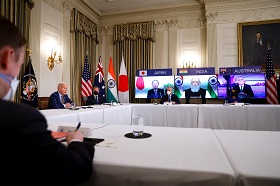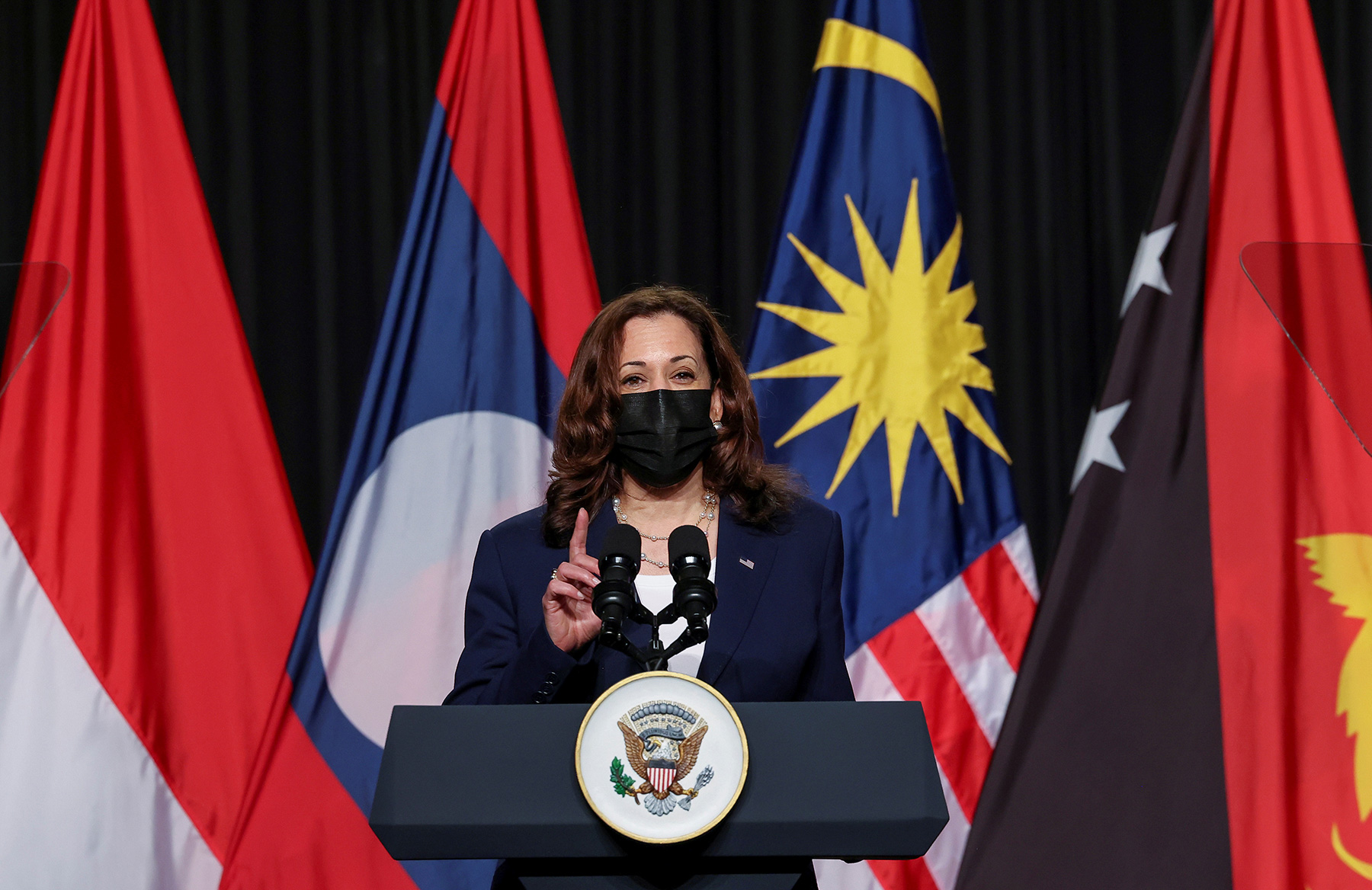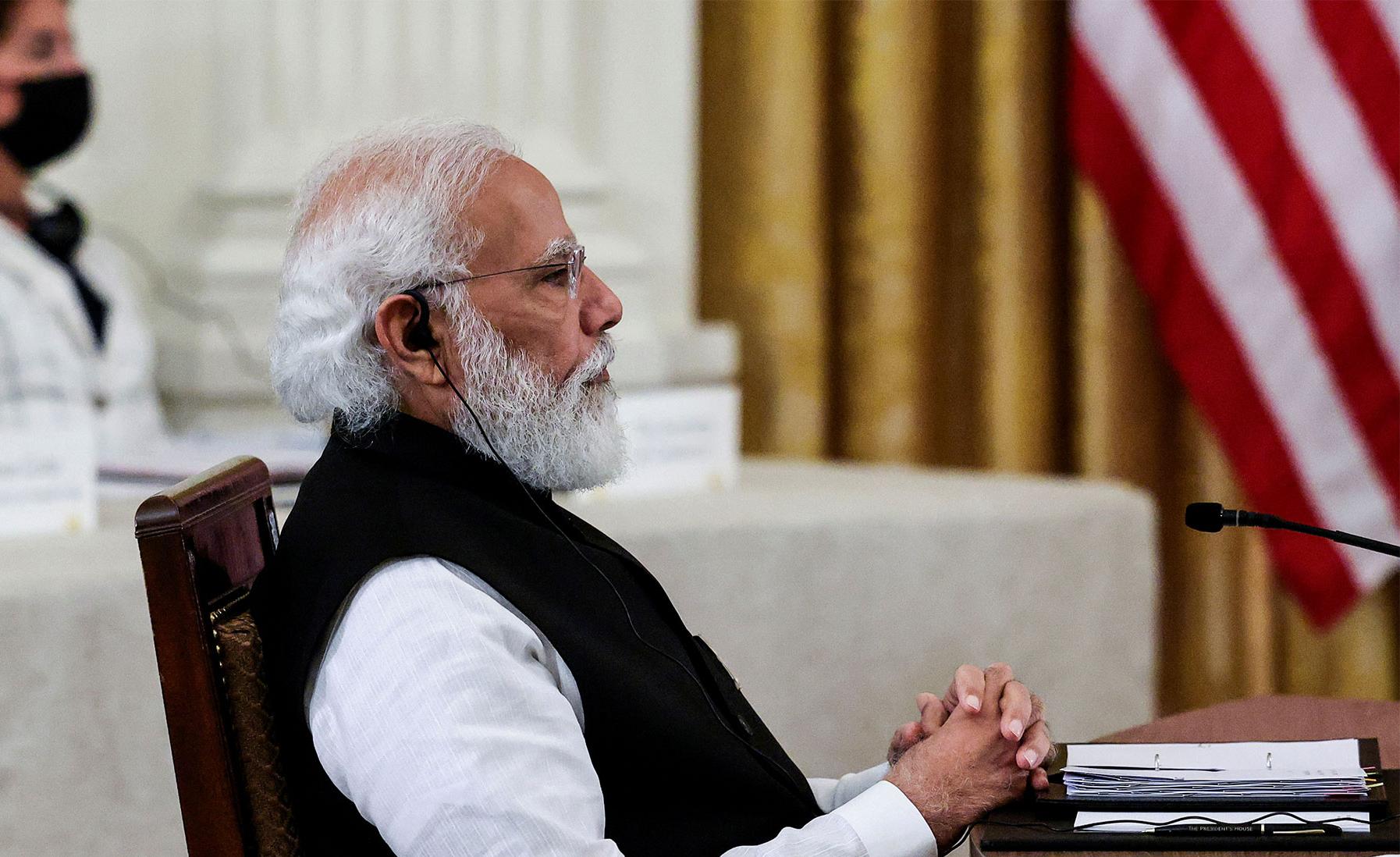The multilateral structure of the new framework is, naturally, aimed at containing China and precluding the successes of the Regional Comprehensive Economic Partnership (RCEP) through shoring up U.S. dominance in the region and exporting American-fashioned institutions, regulatory practices and certification standards for investment projects. It is also designed to reduce China’s admittedly very low chances of joining the CPTPP.
The United States is pursuing goals on several vectors at once. The initiative is most certainly aimed at strengthening what turned out to be a very fragile alliance with India, a country increasingly demonstrating its strategic autonomy in technologies and foreign policy. At the same time, the United States will prioritize the economic component of the U.S.–Japan–Australia–Japan quadrilateral partnership (both within Quad as such and on a bilateral basis), including a tandem with Australia to counter China’s influence in the Pacific Islands. This multilateral format can also serve to strengthen the strategic U.S.–South Korea partnership against the backdrop of anti-Chinese sentiments in the country.
The new multilateral initiative announced by the United States is its last chance—if not to regain integration leadership—to slow down China’s integration moves, prevent the RCEP agenda from becoming even more entrenched in the region, and, as far as possible, diversify the supply chains of those RCEP participants that are strategically important for the United States.
Partly following the logic of the Trans-Pacific Partnership, the United States is counting on expanding the access of its own companies to government tenders of partner countries in engineering and technical development in a number of industries, on the one hand, and accelerating the reshoring process to create new jobs and reduce domestic inflation, on the other. However, in the absence of clearly defined obligations, the United States can hardly count on turning the Indo-Pacific Economic Framework for Prosperity into an effective instrument for exporting its regulatory institutions.
On his visit to Tokyo, U.S. President Joe Biden announced on May 22 the new Indo-Pacific Economic Framework for Prosperity initiative, initially made up of 12 of the region’s countries – the United States, Australia, Brunei, India, Indonesia, Japan, Malaysia, New Zealand, the Philippines, South Korea, Thailand and Vietnam.
A New Political Tool for the Indo-Pacific Dimension: The Ins and Outs of U.S. Goal-Setting
The project is essentially the institutional embodiment of the U.S. revised Indo-Pacific strategy, which is simultaneously offering a flexible alternative to the Trans-Pacific Partnership (or its updated version, the Comprehensive and Progressive Agreement for Trans-Pacific Partnership, CPTPP), to which the United States is in no hurry to return due to political problems domestically.
The multilateral structure of the new framework is, naturally, aimed at containing China and precluding the successes of the Regional Comprehensive Economic Partnership (RCEP) through shoring up U.S. dominance in the region and exporting American-fashioned institutions, regulatory practices and certification standards for investment projects. It is also designed to reduce China’s admittedly very low chances of joining the CPTPP.
The United States is pursuing goals on several vectors at once. The initiative is most certainly aimed at strengthening what turned out to be a very fragile alliance with India, a country increasingly demonstrating its strategic autonomy in technologies and foreign policy. At the same time, the United States will prioritize the economic component of the U.S.–Japan–Australia–Japan quadrilateral partnership (both within Quad as such and on a bilateral basis), including a tandem with Australia to counter China’s influence in the Pacific Islands. This multilateral format can also serve to strengthen the strategic U.S.–South Korea partnership against the backdrop of anti-Chinese sentiments in the country.
The announcement of the initiative sends a number of important strategic signals to the world. First, the United States is clearly concerned that China is “usurping” integration initiatives in the Asia-Pacific (following the withdrawal of the United States from the Trans-Pacific Partnership and the RCEP’s entry into force) and is willing to offer alternative scenarios for developing and building foreign economic strategies to those regional players that are on the radar of both countries. Second, the United States is committed to the Indo-European focus area of its foreign policy, having no intention of abandoning its policy aimed at forming regional and trans-regional alliances to promote its own strategic interests and to consolidate its dominance. Third, the United States is still reluctant to sign regional trade agreements and is trying to maintain a flexible cooperation format with all its might—one that leaves room for manoeuvre. At the same time, the United States is relying on the same areas of economic cooperation that once formed the basis of the Trans-Pacific Partnership (and which were mostly retained in the updated CPTPP that excludes the United States). Specifically, these are: expanding trade ties, strengthening value chains, pursuing the “green” agenda, and working towards energy efficiency in infrastructure development. The goals remain the same: to export institutions, oppose Chinese technological solutions, and to promote U.S. standards for infrastructure projects (which goes against Chinese flexible and non-unified approach).
Trade and Regional Value Chains
The announcement by the United States of the expansion of trade and value chains as key priorities is a clear response to China’s integration activity. Today, China is king of regional integration initiatives in the Asia-Pacific, banking on the maximum involvement of regional players in value chains with the participation of Chinese companies and banks, their increasing dependence on the Chinese market and Chinese goods, and the growth of mutual trade, which will inevitably lead to the expanded use of national currencies in trade relations.
Besides, increased dependence on China in the way of value chains could become an agent of change in the quality of global competition between the two powers: the transition to a competition of the extraterritoriality of sanctions regimes. China has already started to exploit the dependence on the Chinese market to apply sanctions pressure on foreign companies. In the long term, the extraterritoriality of China’s sanctions response, which is based on controlling value chains, may serve as a symmetrical response to U.S. extraterritoriality, which is based on the dollar system.
At the same time, there is no way that the United States has not caught on to what China is doing with its “soft expansion” integration strategy. As a country’s trade dependence on China increases, China starts to revisit its trade agreements with that country, deepening and expanding areas and directions of trade liberalization, moving from limited transactions to comprehensive agreements through a system of additional contracts. This is precisely what happened with China’s trade agreement with Hong Kong, which covered a limited number of service industry sectors and investment in 2004, as well as with Beijing’s agreement with Macau. The agreement with ASEAN evolved in a similar manner. Importantly, China has stayed true to this integration course for two decades.
The RCEP may very well evolve in the same way. While it is true that there are no fundamentally new agreements within this partnership in its current form and that its main purpose remains to harmonize the norms of agreements concluded in the ASEAN+ format and to unify the rules for determining the country of origin of goods, it is entirely possible that trade in services—as well as the rules regarding e-commerce—could be further liberalized in the future. This would, first of all, consolidate China’s dominance in the transport services market. Second, it would turn China into the main sponsor of unified e-commerce rules (China has already seized the initiative at the global level, being one of the initiators and authors of the proposal for electronic trade within the WTO). It is no coincidence that the United States, as part of the new initiative, places special emphasis not only on expanding trade but also on securing high standards of trade in the digital environment.
The new multilateral initiative announced by the United States is its last chance—if not to regain integration leadership—to slow down China’s integration moves, prevent the RCEP agenda from becoming even more entrenched in the region, and, as far as possible, diversify the supply chains of those RCEP participants that are strategically important for the United States. This priority also determines which countries will be involved in the initiative. These include India, which has pulled out of the RCEP, and the “system-forming core” of Japan, Australia, New Zealand, South Korea and the six fastest-growing ASEAN countries. In turn, the exponentially growing dependence on China in the context of post-COVID development exacerbates the dilemma of export-oriented countries that are in dire need of external sources of growth.
The Investment and Infrastructure Vector
Another pillar of the new initiative is infrastructure development, coupled with high technological and environmental standards. For the United States, the Indo-Pacific Economic Framework for Prosperity is another weapon in the fight with China for the new technological standards (including “green” technologies) and a response to the Chinese model of investment and technological expansion promoted through the Belt and Road Initiative (BRI). Large-scale infrastructure projects in the region (within the framework of the BRI) are financed by preferential loans, primarily through China’s Exim Bank (the so-called “debt-trap diplomacy”). At the same time, infrastructure projects are in most cases carried out with the direct participation of Chinese telecommunications companies (Huawei, its subsidiaries HMN Technologies, Hikvision, Cloudwalk, etc.), which provide IT equipment, technological solutions, and their own IT infrastructure management model (installing Chinese servers and ensuring access to stored information). Not only does this provide non-competitive advantages for its companies, but it also gives China complete cyber control over strategically important facilities, minimizing the risks of external cyberattacks and data access.
It is precisely the activities of Chinese telecommunications companies that cause the greatest concern—not only for the United States, which is eager to maintain its hegemony in the IT services market, but also for a number of countries in Asia. Given this, it is unsurprising why U.S. calls for high standards of digital behavior, including standards for cross-border flows and data localization, to be written into a new initiative, are supported by its partners in the region.
The second priority is to agree on commitments in “clean” energy, decarbonization, and the introduction of new environmental and labour standards. This is an obvious attack on China’s “weak spot,” as the country typically exports its dirty industries to go along with its investment expansion.
The investment component of the Indo-Pacific Economic Framework for Prosperity is governed by the same logic as the Blue Dot Network (BDN), which advocates for the harmonization of quality certification for infrastructure projects (based on a pro-Western approach developed in collaboration with the OECD), including environmental standards. The BDN is, in turn, associated with the United States’ Build Back Better World (B3W) programme.
It has to be acknowledged that the U.S. enjoys a much stronger and far more stable position in investment cooperation than it does in trade. While Washington seems to be playing catch-up in terms of trade and supply chains, hoping to contain China (which is picking up steam in the context of its rapid recovery from the acute phase of the pandemic), it is more proactive when it comes to investment, trying to ensure that the Indo-Pacific market continues to be highly dependent on U.S. investments (especially in the ASEAN countries, where U.S. foreign direct investment exceeds that of China, Japan and South Korea).
The Indo-Pacific Economic Framework for Prosperity is designed to promote and strengthen partnerships within the Quad of the United States, Japan, India and Australia. Industry-specific priorities largely overlap with the economic agenda of the Quad, which is aimed at combating climate change and ensuring compliance with regulations in the field of IT, biotechnology, etc.
Moving forward with the initiative could accelerate the formation of investment alliances that involve the United States, Japan and Australia under the Trilateral Partnership for Infrastructure Investment, which is aimed, among other things, at the joint development of rare earth deposits, squeezing China out of the world market for rare earth metals and reducing dependence on critical supplies. A spill-over effect could be an acceleration in the development of hydrogen energy links between Japan and Australia, and those between Australia and South Korea, as well as investment cooperation between India and Japan (Japan remains one of the biggest investors in Indian infrastructure, where its investments and technologies offer an alternative to Chinese capital and Chinese influence in cyberspace).
Another important vector is the consolidation of the U.S.–Australia partnership and the collective opposition to China in the struggle for the Pacific Islands. These islands are of great geostrategic importance for both China and the United States—Papua New Guinea and Fiji, for example, have their own defence forces. Australia’s long-standing close political and economic ties with the island states mean that forming an investment tandem with the country is the best tactical move to contain China’s political and investment activity. This approach has already produced results in recent years (primarily in the Solomon Islands and Kiribati), and it is aimed at gaining access to the raw materials and natural resources of Fiji, Papua New Guinea, Vanuatu, etc.
Conclusion
Announced in May, the initiative is a logical institutional build-on of Washington’s new Indo-Pacific Strategy adopted in February 2022. Its purpose is to contain China and prevent the RCEP from growing in strength.
The United States is essentially sticking to the same industry priorities it once promoted under the Trans-Pacific Partnership, seeking to avoid high trade commitments associated with opening new markets. The goals are same as ever: standardization and more stringent requirements in terms of labour protection, the environment, the protection of infrastructure investments, e-commerce, and the flow and storage of strategically important data. The United States and China have radically different approaches to these issues, and the goal is to promote infrastructure and investment standards that are marked by high barriers to entry and exclusivity and are thus inaccessible to China.
Barack Obama’s logic of the rigid institutionalization of the Asia-Pacific is embodied in the flexible format of the U.S. orientation towards the Indo-Pacific, which complements the earlier announced BDN and B3W in a meaningful way. One gets the impression that the United States is trying to promote the same strategically beneficial economic cooperation agenda on a number of levels at the same time: global cooperation through the BDN; quadrilateral cooperation through the Quad; and now cooperation at the Indo-Pacific level through the Indo-Pacific Economic Framework for Prosperity, put forward as an alternative to the RCEP.
That said, it is difficult to call this new cooperation format a suitable alternative. First of all, we should not overestimate its potential trade efficiency. Given the current conditions, it is all but impossible to alter the institutional environment for companies and reorient partners in the Indo-Pacific (even the friendly ones) without all participants assuming strict obligations to open new markets and introduce tariff and non-tariff liberalization. The “Asian pragmatism” inherent in almost all regional players, even in the face of growing anti-Chinese sentiments among the ruling elites and in the minds of the masses (for example, in India, Japan and South Korea), has increased the dependency on Chinese supplies and the capacious Chinese market at the business level.
Trade appears to be the weak link in the new multilateral initiative. The U.S. is reluctant to take on clear commitments to open markets, which is not in line with the strategic interests of India—the country at which the initiative is primarily geared in terms of rapprochement. India is the largest importer in the region, and it is currently following a protectionist course. The country is thus extremely wary of any formal integration agreements, fearing the risks to its industrialization and competitive pressure on farmers and the service sector.
Partly following the logic of the Trans-Pacific Partnership, the United States is counting on expanding the access of its own companies to government tenders of partner countries in engineering and technical development in a number of industries (primarily, the IT sector, pharmaceuticals, biotechnology, the production of medical equipment and the food industry), on the one hand, and accelerating the reshoring process (returning industrial production to the United States from developing countries) to create new jobs and reduce domestic inflation, on the other. However, in the absence of clearly defined obligations (even if the agenda is concentrated around its traditional competitive advantages relative to China), the United States can hardly count on turning the Indo-Pacific Economic Framework for Prosperity into an effective instrument for exporting its regulatory institutions.







